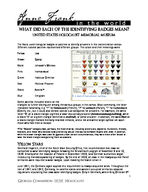what did each of the identifying badges mean?
united states holocaust memorial museum
The Nazis used triangular badges or patches to identify prisoners in the concentration camps. Different colored patches represented different groups. The colors and their meanings were:
Yellow
Jew
Brown
Gypsy
Violet
Jehovah's Witness
Pink
Homosexual
Green
Habitual Criminal
Red
Political Prisoner
Black
Asocial*
Blue
Emigrant
1 A chart of Nazi prisoner markings
Some patches included letters on the triangles to further distinguish among the various groups in the camps. Most commonly, the letter indicated nationality, e.g. "F" for franzosisch (French), "P" for polnisch (Polish), "T" for tschechisch (Czech), etc., but it could also denote special sub-categories for prisoners. For example, the white letter "A" on a black triangle signified a labor disciplinary prisoner (Arbeitserziehungshaftling), while a black "S" on a green triangle identified a strafthaft, or penal prisoner. In addition, the word Blod on a black triangle marked mentally retarded inmates, and a red and white target symbol set apart those who had tried to escape.
*The "Asocial" category was, perhaps, the most diverse, including prostitutes, vagrants, murderers, thieves, lesbians, and those who violated laws prohibiting sexual intercourse between Aryans and Jews. In addition, while the brown triangle was used for gypsies under certain circumstances, they were more often forced to wear the black triangle categorizing them as asocials.
Yellow Stars
Reinhard Heydrich, chief of the Reich Main Security Office, first recommended that Jews be compelled to wear identifying badges following the Kristallnacht pogrom of November 9 and 10, 1938. Shortly after the invasion of Poland in September 1939, local German authorities began introducing mandatory wearing of badges. By the end of 1939, all Jews in the newly-acquired Polish territories were required to wear badges. Upon invading the Soviet Union in
June 1941, the Germans again applied this requirement to newly-conquered lands. Throughout the rest of 1941 and 1942, Germany, its satellite states and western occupied territories adopted regulations stipulating that Jews wear identifying badges. Only in Denmark, where King Christian X*
1
is said to have threatened to wear the badge himself if it were imposed on his country's Jewish population, were the Germans unable to impose such a regulation. The German government's policy of forcing Jews to wear identifying badges was but one of many psychological tactics aimed at isolating and dehumanizing the Jews of Europe, directly marking them as being different (i.e., inferior) to everyone else. It allowed for the easier facilitation of ghettoization, ultimately leading to the deportation and murder of 6 million people. Those who failed or refused to wear the badge risked severe punishment, including death. For example, the Jewish Council (Judenrat) of the ghetto in Bialystok, Poland announced that "... the authorities have warned that severe punishment up to and including death by shooting is in store for Jews who do not wear the yellow badge on back and front."
* The refusal of the Danish authorities to discriminate against the Danish Jews and King Christian's outspoken support of the Jewish community has given rise to the apocryphal story that the king himself wore a yellow star. Though untrue, the story reflects the king's opposition to persecuting Denmark's Jewish citizens and residents and the popular perception of Denmark as a country which protected the Jews. (Source: United States Holocaust Memorial Museum)
2
